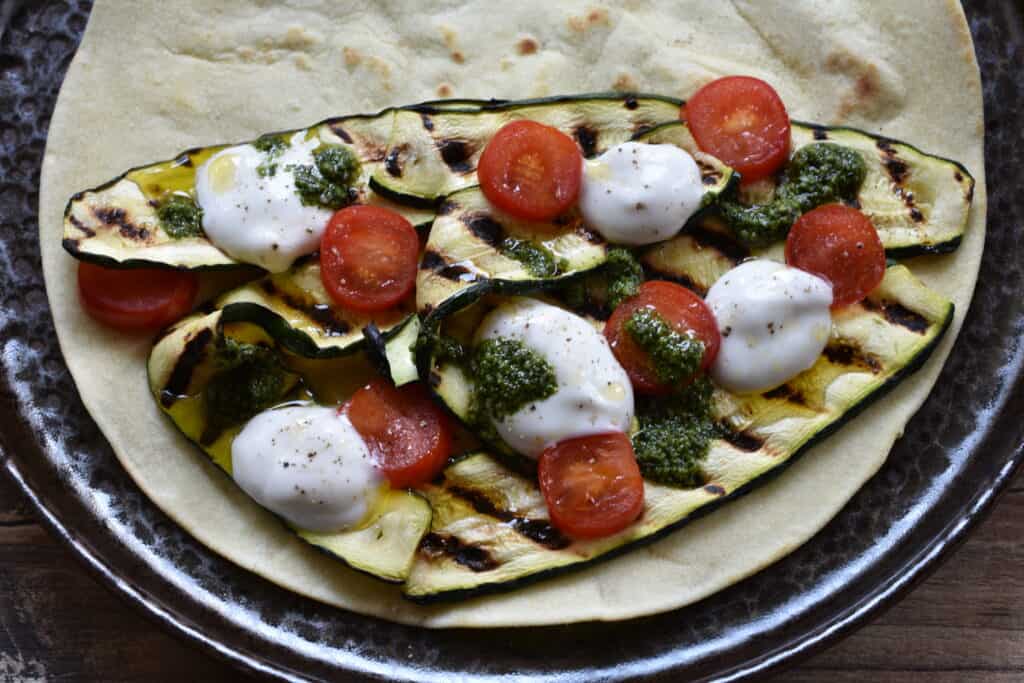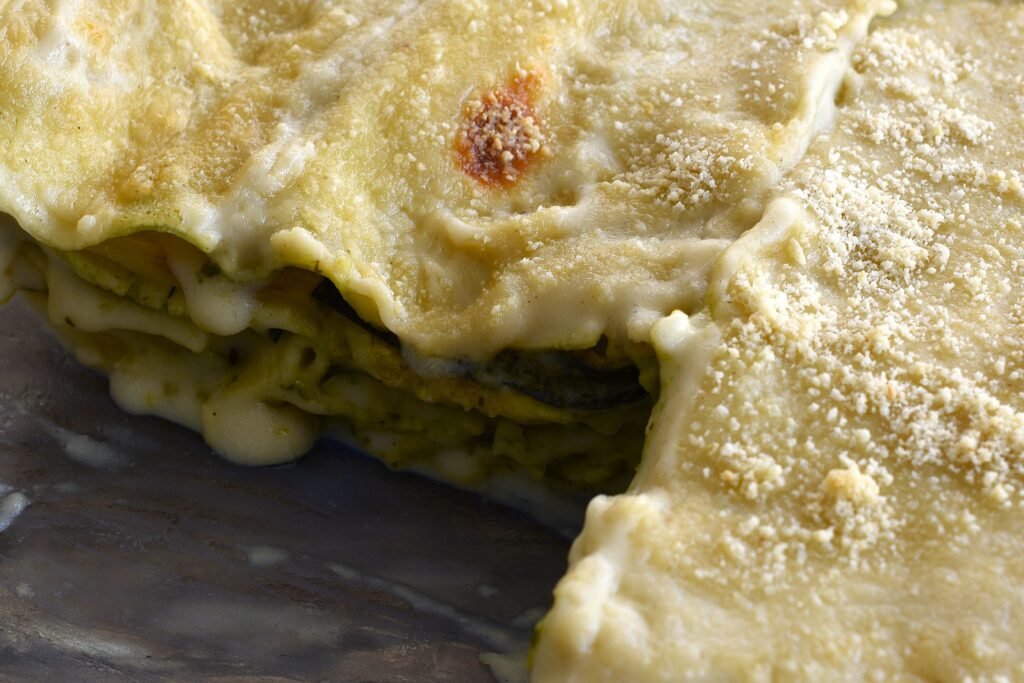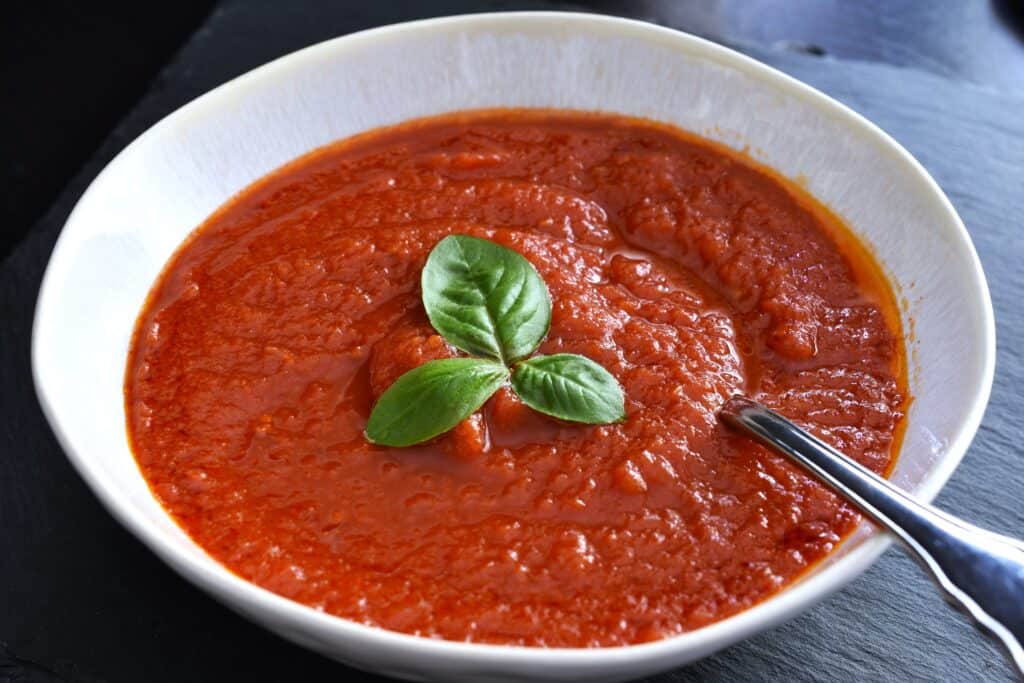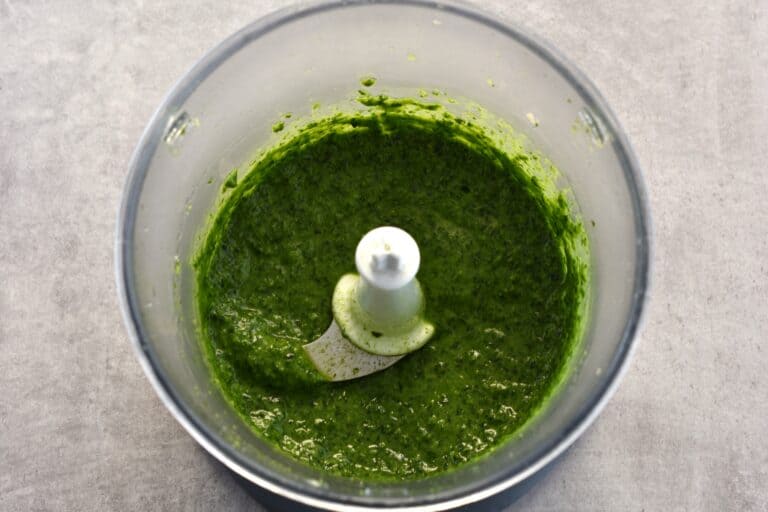Here’s a vegan basil pesto recipe that tastes exactly like authentic Italian pesto alla genovese! Lots of non-vegan Italians have tried this pesto recipe and say they can’t tell the difference! Apart from tasting authentic, it’s also vibrantly green, creamy, and emulsified! This raw vegan basil pesto won’t oxidise and leave you with discoloured pesto that may taste great but looks terribly unattractive. It’s velvety smooth and creamy, like pesto made in a mortar and pestle, yet it takes a quarter of the time to make. The trick is to let the food processor do all the hard work and then finish it off in mortar and pestle to render it irresistibly smooth and emulsified.

About this vegan basil pesto recipe
This is probably the best vegan basil pesto recipe you’ll ever try. It takes just 20 minutes to make from start to finish, with stellar results. The addition of a few drops of lemon juice ensures that your pesto remains emerald green right up until it’s on the plate in front of your guests. The lemon juice is absolutely undetectable. And, in case you didn’t know, all commercial and artisan pestos contain either citric acid (basically lemon juice in concentrated powder form) or ascorbic acid, or both. The function of lemon juice, citric acid or ascorbic acid, is to prevent oxidation and ensure that the pesto remains a beautiful bright green.
I’m immensely proud of this recipe. It took me more time to perfect it than I care to admit. Vegan basil pesto is a hard one to crack. Everyone wants the ultimate basil pesto in terms of authentic Italian taste and texture, but not many people want to spend an hour making it with a mortar and pestle! Apart from the time factor, it’s actually really hard work! Some Italians might consider this recipe cheating because it uses a food processor – but who cares? It delivers on all fronts: appearance, flavour, and consistency! Without all the hard work. What more could you possibly want?!

Get creative and serve this vegan basil pesto on pasta or gnocchi, in lasagne, in sandwiches and wraps, as a dip with crudités, or on focaccia. Some Italians put a dollop in vegetable soups. Chefs use it to create intricate garnishes in high-end restaurants. You can slather it on bread like I do – with or without homemade spreadable vegan cheese. So delicious!
If you’re interested in the origins of basil pesto, read on. Otherwise, feel free to jump to the recipe!
The origins of basil pesto
Basil pesto originates from the region of Liguria in northern Italy. Its history dates back to ancient Roman times when a similar sauce called moretum was made by crushing garlic, cheese, herbs, and olive oil.
The modern basil pesto we know and love today took shape in the mid-19th century in Genoa, Liguria’s capital. Genovese cooks refined the recipe, substituting basil for other herbs, introducing pine nuts, and using Parmesan or Pecorino cheese. This exquisite sauce became known as pesto alla genovese, highlighting its Genoese roots.
Traditionally made with fresh basil leaves, garlic, pine nuts, Parmesan or Pecorino cheese, and high-quality olive oil, basil pesto is a beloved staple in Italian cuisine. Its versatility extends beyond pasta, and it has transcended its humble origins to become a popular global culinary delight.
What is vegan pesto made of?
This vegan basil pesto uses the same basic ingredients as traditional Genoese pesto, but it does not contain cheese. Vegan parmesan cheese emulates Parmesan or Pecorino in this dairy-free version without compromising on flavour or texture.
Important
For the best results, I highly recommend following this recipe exactly. Every detail matters. Adhering to the specified ingredients and techniques will help you achieve a pesto Genovese that is rich, aromatic, and authentically Italian. Trust the process, and you’ll be rewarded with a sauce that elevates any dish it accompanies. Enjoy your culinary creations!

How to make raw vegan basil pesto
Ingredients and substitutions
The exact quantities of each ingredient are indicated in the recipe card at the bottom of this page.
Basil
Only use fresh basil leaves for making pesto. When buying basil for pesto, it’s essential to choose very fresh, high–quality basil leaves to ensure the best flavour and aroma in your sauce. Fresh basil should look lush and vibrantly green. Avoid basil that’s bruised or limp. Basil is best when it’s picked young and hasn’t been allowed to bolt (produce flowers), as flowering can result in a bitter taste. If available and within your budget, consider choosing organic basil, which is grown without synthetic pesticides or herbicides. Ideally, grow your own. I grow basil and other herbs on my balcony, which is priceless.
Pine nuts
Pine nuts are the classic choice for traditional Genovese pesto. These tiny little nuts have a mild, slightly sweet, and buttery flavour that is subtle yet distinctive. When ground, they become creamy, which makes them perfect for pestos. If you need an alternative due to allergies or availability, there are several nuts and seeds you can use to make a tasty pesto variation. Some popular options include walnuts, pistachio nuts, almonds, cashews, pecans and sunflower seeds. When substituting nuts or seeds in pesto, bear in mind that the flavour and texture of your pesto will vary based on the choice you make. You may need to adjust the quantities and other ingredients to balance the flavour to your liking.
Experiment with different nut and seed options to create a pesto that suits your taste preferences and dietary restrictions. You might discover a new favourite pesto variation in the process!
Should you toast the nuts for pesto?
Some basil pesto recipes recommend toasting the nuts to enhance their flavour and add depth to your pesto. I personally don’t toast mine because I prefer to grind raw pine nuts down to a smooth paste which makes for a silkier, more emulsified pesto. It also means my vegan basil pesto is 100% raw. If you want to try toasting them, simply toast them in a dry pan over low-medium heat until they become fragrant and lightly golden.
Oil
This is not a recipe where you can skimp on the oil and get away with it. Go for the best extra virgin olive oil you can find. Ideally, it should be organic, cold-pressed, and fragrant.
Garlic
Selecting the right garlic for pesto is crucial, as garlic is one of the key flavour components. Look for fresh bulbs with firm cloves. Avoid garlic bulbs that feel soft or have started sprouting. The papery skin should be dry and tight. After you have removed the skin, the clove of garlic should be almost white. Don’t use discoloured, wizened cloves.
You can adjust the quantity of garlic in your pesto based on your personal taste. Start with a moderate amount and add more if needed after tasting the pesto. Some Italians prefer pesto without garlic, while some like basil pesto with the robust and spicy kick you get from garlic. It’s all down to personal preference.
Mince the garlic beforehand, even if it is going in the food processor anyway. This allows its oils to infuse the pesto, enhancing its overall taste.
Lemon juice
Use only freshly squeezed lemon juice in basil pesto. Fresh lemon juice has a vibrant, zesty taste that can enhance your pesto. Avoid bottled lemon juice, as it may have a different flavour profile and can contain preservatives. A teaspoon per 50 g of basil leaves is sufficient to prevent your pesto from oxidising and turning brown.
I’ve tried other alternatives to prevent oxidization. Citric acid is harder to find and doesn’t do the job as well as simple lemon juice, in my opinion. Another thing I tried and scrapped immediately was blanching the basil leaves. Believe me, it’s a terrible idea. My gut instinct told me so, but I had to try it out for myself to fully understand why.
Why it’s a bad idea to blanch basil leaves
Blanching basil involves briefly immersing the leaves in boiling water and then quickly cooling them in ice-cold water. This process causes the basil to lose some of its delicate flavour and aromatic oils. Basil’s fresh, pungent, herbaceous aroma is a crucial element of pesto, and blanching dulls these characteristics.
You can’t consider blanched pesto. The leaves taste cooked because they are cooked, albeit briefly. The leaves become limp, negatively affecting the texture and flavour of the pesto.
Basil leaves are known for their beautiful green colour, contributing to the visual appeal of pesto. Blanching causes the leaves to turn darker and lose their vibrant emerald-green hue.
Salt
I use natural, unrefined grey sea salt in all my recipes.
When making pesto with a mortar and pestle, coarse salt helps to grind down the leaves. However, fine salt is better when using a food processor. That way, we can be certain no large grains escape the blades, leaving us with gritty bits in the pesto. In this recipe, where we use a food processor to start with and then a mortar and pestle to finish it off, I recommend using fine salt as opposed to coarse.
Nutritional yeast flakes
Nutritional yeast flakes provide the cheesy flavour in this dairy-free basil pesto. Make sure you use nutritional yeast flakes and not powder. For those of you who are unfamiliar with nutritional yeast, here’s a brief explanation of what it is and how we vegans use it.
Nutritional yeast is a deactivated yeast that is commonly used as a seasoning and flavour enhancer in cooking, especially in vegan and vegetarian dishes. It is typically grown on molasses and then harvested, washed, and dried to deactivate the yeast.
Nutritional yeast has a nutty, cheesy flavour, which makes it a popular ingredient in dairy-free and vegan recipes as a substitute for cheese. It is often used to add umami richness to dishes such as sauces, soups, dressings, and vegan cheese alternatives.
In addition to its savoury flavour, nutritional yeast also has several nutritional benefits. It is a good source of protein, vitamins (including B vitamins such as B12), and minerals, as well as being low in fat and sodium. Many people choose to incorporate nutritional yeast into their diet for its potential health benefits and as a way to boost the flavour and nutritional content of their meals.
Vegan parmesan cheese
I recommend using homemade vegan parmesan cheese for this recipe. My recipe takes less than 5 minutes to make and uses just 4 ingredients: raw cashew nuts, raw almonds, nutritional yeast and salt. It isn’t real cheese, but it is remarkably similar thanks to its tangy, salty flavour, grainy consistency and cheesy taste. It even looks like real parmesan.

How to make vegan basil pesto
Method
You’ll find step-by-step instructions with photos in the recipe card at the bottom of this page.
- Place half of the basil leaves in the blender of a food processor, along with the pine nuts, extra virgin olive oil, garlic, salt, and lemon juice.
- Blend until the basil leaves are roughly chopped and there is enough room to add the rest.
- Add the rest of the basil leaves and continue blending until smooth.
- Add the nutritional yeast flakes and vegan parmesan cheese and blend again briefly to amalgamate.
- Using a spatula, scrape the pesto out of the food processor and transfer it to a mortar. Begin emulsifying the pesto with the pestle, using a gentle and prolonged rotary motion against the bottom and walls of the mortar. Continue like this for 5 – 10 minutes until the pesto is creamy, smooth, and emulsified.
How to serve your vegan basil pesto
This raw vegan basil pesto alla genovese is so delicious and versatile – you can enjoy it in lots of different ways! Here are some of my favourites:
On pasta
Pasta with basil pesto is a timeless classic , with or without other ingredients. Homemade vegan basil pesto is perfect on spaghetti, linguine, trofie, fusili, maltagliati, etc. For something different, try pairing vegan basil pesto with linguine and fresh cherry tomatoes or spaghetti with spiralled courgettes, for example.


On gnocchi
Vegan basil pesto is a great sauce for gnocchi. I love making tris di gnocchi, which is gnocchi with three different sauces. My seasonal favourites at this time of the year are fresh tomato pasta sauce, melted vegan butter with sage, and this vegan pesto Genovese.


In sandwiches and wraps – vegan basil pesto is fantastic spread on bread or bruschette with vegan cheese or as a filling ingredient for delicious sandwiches and wraps.


On vegetables – vegan basil pesto is used in many traditional Ligurian vegetable dishes like patate e fagiolini al pesto (potatoes and green beans with pesto) or lasagne al pesto e zucchini (lasagne with pesto and courgettes).


As a pizza topping – add a little vegan basil pesto to your pizza topping after it has come out of the oven. It goes particularly well with tomatoes, vegan mozzarella and vegetable toppings like aubergines, courgettes and peppers.
On focaccia – You can add basil pesto to traditional focaccia. I recommend using it raw after the focaccia comes out of the oven. Thin your vegan basil pesto down with a little oil and drizzle it over the top. In Liguria, it’s also used as a filling ingredient for focaccia di Recco, often with stracchino (an Italian cheese), which you can also buy or make vegan.
As a dip – You can serve vegan basil pesto to dip raw vegetables and grissini as part of an antipasto or buffet spread.
How to store vegan basil pesto
Spoon your vegan basil pesto into a jar and press it down with a spoon to eliminate any air pockets. Smooth the surface over with the back of the spoon. Pour a thin layer of oil over the pesto and put the lid on. Store it in the fridge, where it will keep for 3 – 4 weeks. Every time you take some pesto out of the jar, remember to flatten the surface again and replenish the layer of oil. The layer of oil acts as a protective seal, creating a barrier between the pesto and the air. This helps to slow down the oxidation process and preserve the freshness of the pesto for a longer period.

Can you freeze vegan basil pesto?
Yes, you can. While it’s not something I normally do myself, you can freeze basil pesto successfully. I recommend you freeze it in portions by spooning it into a silicone mould designed for freezing small amounts of food in cubes or in an ice cube tray. Once frozen, you can tip the cubes of basil pesto into a ziplock bag so that you can use the tray again for ice or other things. Store it in the freezer, where it will keep for up to 3 months. I rarely do this because it keeps well in the fridge for up to a month with a thin layer of oil covering the surface, and freezing it will alter the taste and texture slightly.
I’m sure you’ll love this delicious, creamy vegan basil pesto recipe! If you try it and like it, I’d love to hear about it! Let me know in the comments below, or take a quick pic and share it on social media. Don’t forget to tag me on Instagram or Facebook @vegan_hot_stuff – I love seeing your re-creations!
Frequently asked questions
Is basil pesto vegan?
Shop-bought pesto isn’t usually vegan unless it specifically says so on the jar. Barilla makes a half-decent vegan pesto if you’re looking for a store-bought, dairy-free pesto. Some non-vegans say it’s better than the normal version.
Why is some pesto not vegan?
Commercially produced pesto often contains ingredients like milk, milk powder, milk protein, maize fibre, cashew nuts, lactose whey, whey protein concentrate, wheat flour, butter, and potato. These are some of the ingredients that I found on the labels of 3 of the most famous Italian brands: Barilla, Buitoni, and Giovanni Rana. Artisan basil pesto is not made with any of those ingredients. However, artisan basil pesto contains
What are the ingredients in basil pesto?
There are only seven ingredients in artisan basil pesto: fresh basil leaves, extra virgin olive oil, pine nuts, garlic, salt, Parmesan or pecorino cheese, and lemon juice, citric acid, or ascorbic acid as an antioxidant. It’s therefore really easy to veganise basil pesto and steer clear of unwanted and unnecessary additives and ingredients obtained through the exploitation of animals.
How do you make vegan basil pesto Genovese?
Pesto Genovese is the original basil pesto recipe from Genoa, Italy. Traditionally, it’s made with a mortar and pestle. Some people take the shortcut and use a food processor to save time, but the best pesto is made using a mortar and pestle. In the recipe on this page, the initial hard work is done using a food processor. Then, the pesto is finished off with a mortar and pestle to make it super creamy and smooth. Real Genoese pesto is made with 7 simple, fresh ingredients: basil, olive oil, pine nuts, garlic, salt, Parmesan or Pecorino cheese and an optional antioxidant like lemon juice or citric acid to keep it green. To make Genoese pesto vegan, just substitute the Parmesan or Pecorino with a vegan parmesan and/or nutritional yeast. Or simply omit it. In that case, you can reduce the oil.
What is a good substitute for pine nuts in vegan pesto?
Some substitutes for pinenuts include walnuts, cashews, pistachios, sunflower seeds, pumpkin seeds, and hemp seeds. These alternatives provide a similar texture and nutty flavour.
What is a substitute for Parmesan cheese in pesto?
You can easily substitute Parmesan cheese with homemade or shop-bought vegan parmesan cheese and/or nutritional yeast flakes in basil pesto. Basil pesto has an intense, pungent flavour, making it almost impossible to detect what kind of cheese is in it.
How long does vegan pesto last in the fridge?
The vegan basil pesto recipe on this page will last for a month or more if stored correctly. See step 6 in the recipe card above for details on how to keep it fresh for weeks. For shop-bought basil pesto, it’s best to read the label for indications on how long it will last as this varies from one brand to another.
I hope you liked this recipe for homemade vegan basil pesto! If you did, it would be great if you could give it 5 stars and leave a comment below! It helps other readers to find my content and posts and ultimately makes my blog more successful! Thank you so much for your support! Deborah xx
Before you go, maybe you’d like to have a look at some other delicious vegan recipes…






Would you like to receive my recipes as soon as I publish them? Subscribe below!










